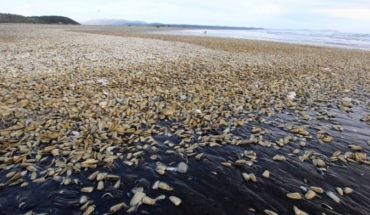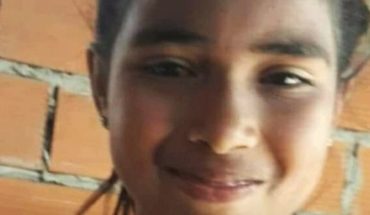Isabel and María Jusayú are two sisters of the Wayúu ethnic group who arrived in the desert Colombian department of La Guajira from Venezuela, thinking that they would have a better future, with work and food for their children, but they encountered another reality: lack of opportunities, hunger, drought and the state abandonment that has led them to live with nothing. La Guajira, where 21 children have died from malnutrition so far this year and hunger “became a landscape”, and Chocó, are the departments with the most deaths from child malnutrition in the country, although hunger is a reality that is found in every corner of Colombia. “When we get half a kilo of rice we do not have to eat the elders, we stop eating so that the children eat perfectly,” she says in an interview with Efe Isabel, surrounded by the children of both in a small construction where, at night, seven people sleep. Despite the situation, Isabel and María, who are going to eat a plate of rice with beans, their only food of the day, do not consider returning to Venezuela because in Colombia “the children are studying”, they receive a “better education”, despite the fact that sometimes they have to miss class to help their mothers wash clothes to get food. An indigenous Wayuu boy walks in the El Aeropuerto settlement, May 14, 2022, in Uribia, Colombia. Territory without borders In La Guajira, in the extreme north of the country, the situation has worsened in recent years with the arrival of Wayúus who resided in Venezuela and fled with the deepening of the crisis. For them there is only one territory, there are no borders, so they transit between Colombia and Venezuela as if it were the same country. In the municipality of Uribia hundreds of Wayúus who arrived in recent years from Venezuela seized an old airport that they turned into a settlement where they live in subhuman conditions. Almost 13,500 people now live in El Aeropuerto, most of them women who have arrived alone, Antonio José Jayariyu tells EFE, denouncing the lack of attention from institutions, especially health institutions, since many of the women arrive pregnant and are not followed up. “We were used to light, cold water and when they invaded here (El Aeropuerto) we also began to get involved,” says Isabel, who arrived in Colombia in 2018.
“It was very difficult: how to get to eat, get a house. At first we started by frying arepitas and selling them for 500 Colombian pesos (about 12 cents), that gave us to eat daily,” continues Isabel, who adds that at that time she and her sister were pregnant “and it was difficult to get a job.” The Wayúu also inhabit the rural areas of La Guajira, where they dedicate themselves to grazing and the manufacture of handicrafts, jobs that, however, are not enough to survive, usually being at the mercy of humanitarian aid that is often not enough. In the enramada, the community space of the Wayúu of the community of Ishamana, the children draw what they would like to have: dog food, a court, a ball, a bicycle, a house or a garden, while a nutritionist measures them to check that they are not suffering from malnutrition. A Wayúu indigenous woman eats flavored ice on May 14, 2022 in the Witka community, in Manaure (Colombia). EFE Fighting malnutrition The Food Bank of La Guajira has developed a successful model, focused on children under five and their mothers, in which it closely monitors children to ensure that they do not fall into malnutrition and that they have the size that corresponds to them. In addition to providing them with food packages, and in the case of children suffering from micronutrient malnutrition, the organization has promoted a leadership program from which in alliance with Wayúu women they sell their traditional backpacks. Right now they serve more than 2,000 families, both in rural areas and in Riohacha itself, capital of La Guajira, including that of Wilmer, a seven-year-old boy with the height and stature of one of three. Wilmer and his nine siblings are chronically malnourished, as are their mother and probably their children, and it’s something they’ll never recover from, explains Juan Carlos Buitrago, director of the Association of Food Banks of Colombia (ABACO), adding that it is already “an irreversible disease.” An indigenous Wayúu boy eats flavored ice on May 14, 2022 in the Witka community, in Manaure, Colombia. EFE Signs of malnutrition To identify malnutrition, “the first thing is to make a diagnosis and nutritional screening where weight, height and brachial perimeter are taken into account”, and identify signs such as “the depigmented hair, areas of alopecia or ‘old man’ appearance,” Atenas Urdaneta, a nutritionist with the Food Bank team that follows the communities, tells EFE. Weekly they visit the communities adhering to the program to follow up on the minors: if they do not meet the established goals and malnutrition persists, the screening program is suspended, in a way to encourage mothers to follow the micronutrient treatment. We recommend you read: And even if “it is remedied”, children “will never develop like a normal child”, laments Urdaneta. Chronic malnutrition is a disease that delays all brain, cognitive and emotional development. When the Food Bank found Wilmer in the Witka community he didn’t speak, now he can communicate and even smiles. And while the organizations reach the most remote parts of La Guajira, the institutions owe an outstanding debt to the Wayúu communities, where hunger “became a landscape,” in Buitrago’s words, and children continue to die from malnutrition. Fanny Lu dedicates musical tribute to her daughter Valentina
where hunger became a landscape
May 21, 2022 |





